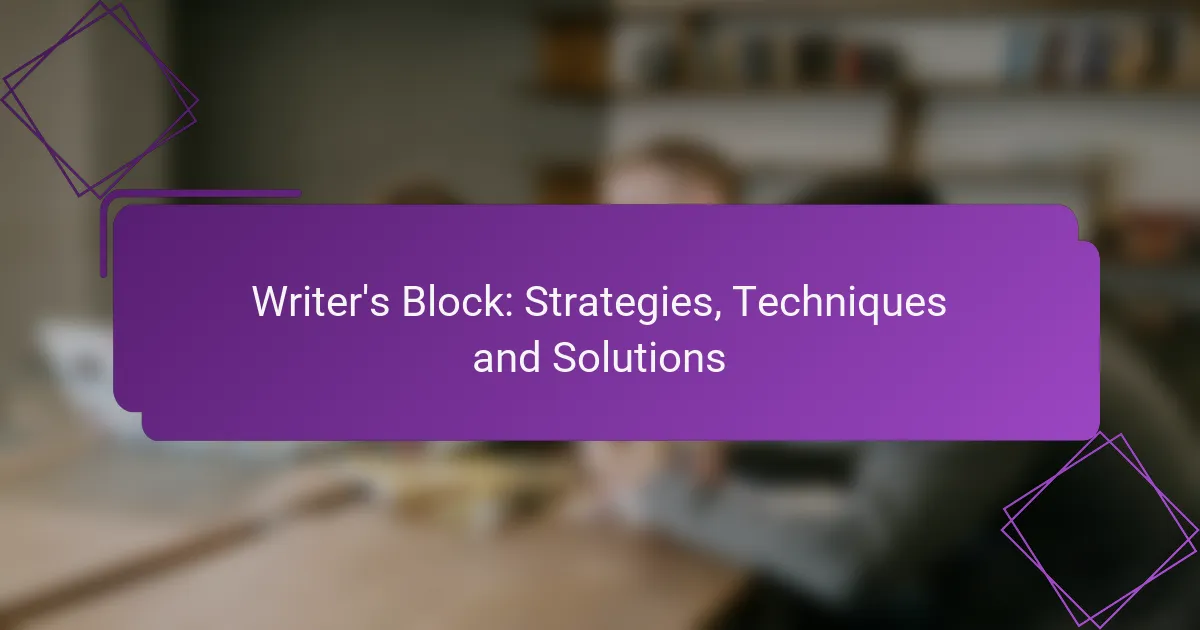Emotional attachment can often lead to overwhelming feelings, making it essential to explore effective detachment techniques. By cultivating a healthier mindset and shifting our perspective, we can manage our emotions more effectively, leading to clearer thinking and better decision-making. Embracing these strategies allows for the establishment of healthier boundaries and a more resilient approach to relationships.

What are effective emotional detachment techniques?
Effective emotional detachment techniques help individuals manage their feelings and reduce emotional overwhelm. These methods promote a healthier mindset, allowing for clearer thinking and improved decision-making.
Mindfulness meditation
Mindfulness meditation involves focusing on the present moment without judgment. This practice helps cultivate awareness of thoughts and feelings, enabling individuals to observe their emotions rather than react to them.
To start, find a quiet space, sit comfortably, and concentrate on your breath. Aim for sessions of 10-20 minutes daily to build a consistent practice. Over time, this technique can enhance emotional resilience and reduce attachment to negative feelings.
Cognitive restructuring
Cognitive restructuring is a technique used to identify and challenge negative thought patterns. By reframing these thoughts, individuals can alter their emotional responses and develop a more balanced perspective.
Begin by noting down distressing thoughts and questioning their validity. Replace them with more constructive alternatives. This process can take time, but regular practice can significantly lessen emotional attachment to harmful beliefs.
Journaling for clarity
Journaling serves as a powerful tool for emotional detachment by providing a space to express and process feelings. Writing about experiences can help clarify thoughts and reduce emotional intensity.
Set aside time each day to write freely about your emotions and experiences. Focus on what triggered your feelings and how you responded. This practice can help you gain insights and distance from overwhelming emotions.
Visualization exercises
Visualization exercises involve imagining scenarios that promote emotional detachment. This technique can help individuals mentally rehearse responses to emotional triggers, fostering a sense of control.
To practice, visualize a situation that typically evokes strong emotions. Imagine yourself responding calmly and rationally. Regularly engaging in this exercise can strengthen your ability to detach from emotional responses in real-life situations.
Breathing techniques
Breathing techniques are effective for managing stress and promoting emotional detachment. Controlled breathing can help calm the nervous system and reduce feelings of anxiety or overwhelm.
Try the 4-7-8 technique: inhale for 4 seconds, hold for 7 seconds, and exhale for 8 seconds. Repeat this cycle a few times whenever you feel emotionally charged. This simple practice can create a sense of calm and help you detach from intense emotions.
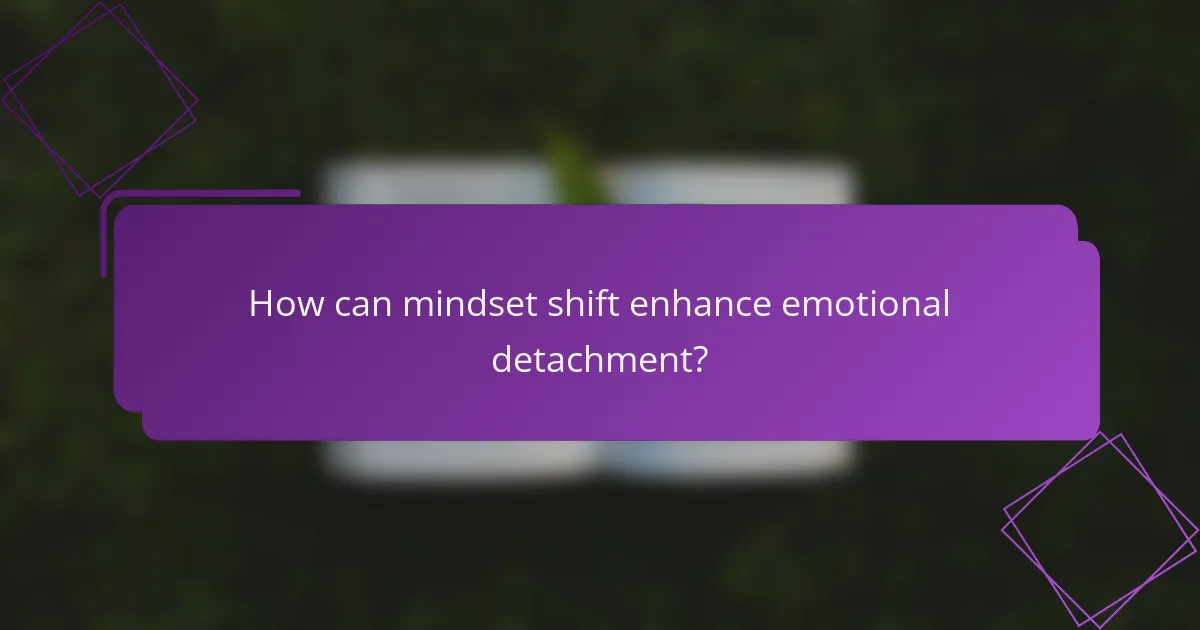
How can mindset shift enhance emotional detachment?
A mindset shift can significantly enhance emotional detachment by fostering a more resilient and adaptive approach to relationships and experiences. By changing how you perceive challenges and emotional ties, you can create healthier boundaries and reduce the intensity of emotional attachments.
Adopting a growth mindset
Adopting a growth mindset involves believing that your abilities and intelligence can be developed through effort and learning. This perspective encourages you to view emotional challenges as opportunities for personal growth rather than as threats. For example, instead of feeling overwhelmed by a breakup, you might see it as a chance to learn about yourself and improve future relationships.
To cultivate a growth mindset, practice reframing negative thoughts into constructive ones. When faced with emotional stress, ask yourself what you can learn from the situation. This shift in thinking can help you detach more easily from unhealthy attachments.
Practicing self-compassion
Practicing self-compassion means treating yourself with kindness during difficult times, rather than harsh self-criticism. This approach allows you to acknowledge your feelings without becoming overly attached to them. For instance, when experiencing sadness, remind yourself that it’s okay to feel this way and that others share similar experiences.
To enhance self-compassion, consider engaging in mindfulness practices, such as meditation or journaling. These activities can help you observe your emotions without judgment, making it easier to detach from them and maintain emotional balance.
Setting healthy boundaries
Setting healthy boundaries is crucial for emotional detachment, as it defines the limits of what you will accept in relationships. Clear boundaries protect your emotional well-being and prevent unhealthy attachments from forming. For example, if a friend consistently drains your energy, it’s essential to communicate your needs and limit your interactions.
To establish effective boundaries, identify your emotional triggers and decide how you want to respond. Use assertive communication to express your limits clearly. Remember, saying “no” when necessary is a vital aspect of maintaining your emotional health and fostering detachment.
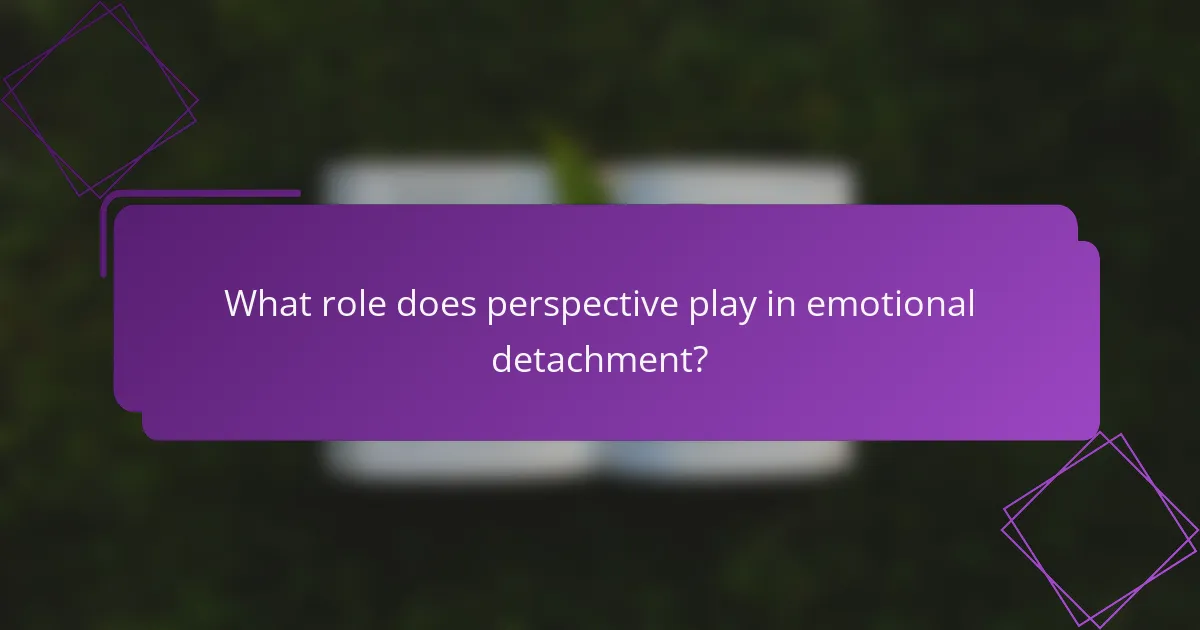
What role does perspective play in emotional detachment?
Perspective is crucial in emotional detachment as it shapes how we interpret and respond to our feelings and experiences. By adopting a different viewpoint, we can reduce emotional reactivity and foster a sense of calmness and clarity.
Viewing situations objectively
Viewing situations objectively involves stepping back from emotional involvement and assessing circumstances based on facts rather than feelings. This can be achieved by asking yourself what you would advise a friend to do in a similar situation. By focusing on the facts, you can diminish emotional biases and make more rational decisions.
For instance, if you feel hurt by a friend’s comment, consider the context and intent behind their words. This shift in perspective can help you respond more constructively rather than reactively.
Understanding impermanence
Understanding impermanence is recognizing that all emotions and situations are temporary. This mindset can help you detach from overwhelming feelings by reminding you that they will eventually pass. Embracing the transient nature of life can reduce the weight of negative emotions.
For example, when facing a challenging situation, remind yourself that it is just one moment in time and that change is inevitable. This awareness can foster resilience and a more balanced emotional state.
Reframing negative thoughts
Reframing negative thoughts involves altering your interpretation of a situation to view it in a more positive or neutral light. This technique can help you detach from distressing emotions by shifting your focus from problems to potential solutions or lessons learned.
For instance, instead of thinking, “I failed at this task,” consider reframing it to, “I learned valuable lessons that will help me improve next time.” This shift can empower you and reduce emotional burden.
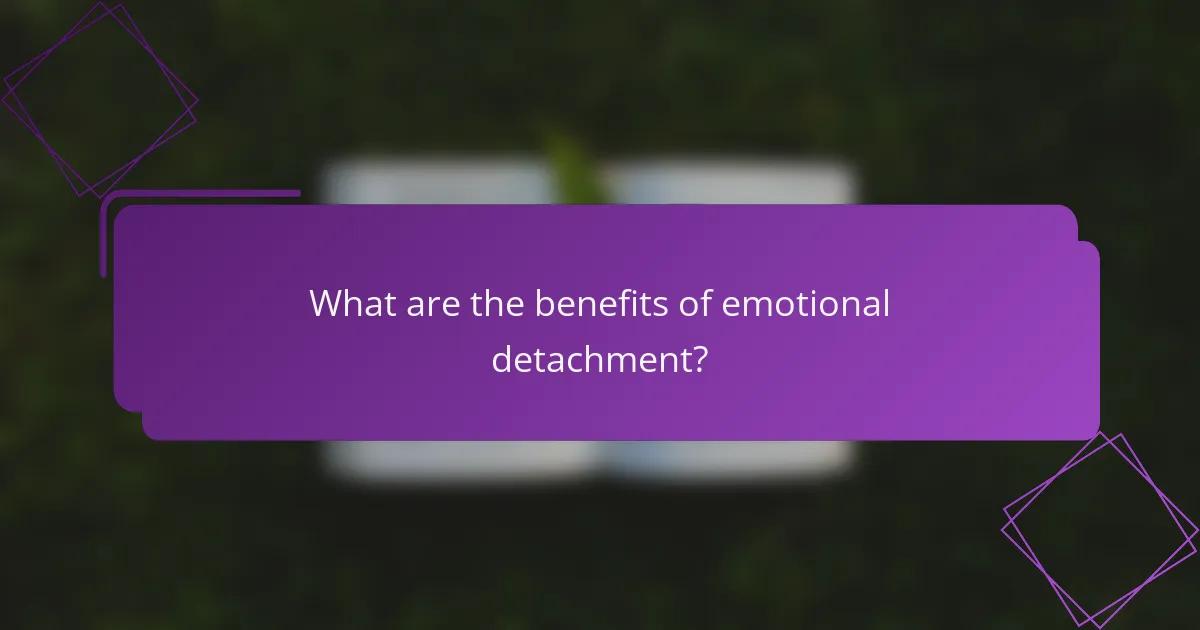
What are the benefits of emotional detachment?
Emotional detachment offers several advantages, including reduced stress and improved clarity in decision-making. By distancing oneself from overwhelming emotions, individuals can navigate their thoughts and relationships more effectively.
Improved mental health
Emotional detachment can lead to better mental health by minimizing anxiety and depression. When individuals learn to separate their feelings from their thoughts, they often experience a decrease in emotional turmoil, allowing for a more balanced state of mind.
Practicing techniques such as mindfulness and cognitive restructuring can help cultivate this detachment. For example, setting aside time each day for reflection can enhance emotional regulation and promote a healthier mindset.
Enhanced decision-making
Detachment from emotions can significantly enhance decision-making abilities. When emotions cloud judgment, it can lead to impulsive choices that may not align with long-term goals. By adopting a more objective perspective, individuals can evaluate situations more rationally.
To improve decision-making, consider using a pros and cons list or seeking input from trusted friends. These strategies can help clarify thoughts and reduce the influence of fleeting emotions on important choices.
Stronger relationships
Emotional detachment can foster stronger relationships by promoting healthier boundaries. When individuals are less reactive to emotional triggers, they can engage in more constructive conversations and resolve conflicts more effectively.
To strengthen relationships, practice active listening and empathy while maintaining a level of detachment. This approach allows for understanding without becoming overwhelmed by emotions, leading to more meaningful connections with others.

What are common misconceptions about emotional detachment?
Emotional detachment is often misunderstood, leading to several misconceptions that can hinder personal growth and relationships. Many people equate detachment with negative emotions or behaviors, which can create barriers to understanding its true purpose and benefits.
Detachment equals apathy
A common misconception is that emotional detachment means being indifferent or uncaring. In reality, detachment is about maintaining a healthy emotional distance while still being engaged and empathetic. It allows individuals to process their feelings without becoming overwhelmed by them.
For example, a person can support a friend in distress without absorbing their pain. This balance helps maintain emotional health and prevents burnout in relationships.
Detachment is permanent
Another myth is that once someone becomes emotionally detached, they will remain that way indefinitely. Detachment is not a fixed state; it can be a temporary strategy to cope with overwhelming emotions or situations. Individuals can choose to engage emotionally again when they feel ready.
Recognizing when to detach and when to reconnect is crucial. This fluidity allows for emotional resilience and adaptability in various life circumstances.
Detachment is unhealthy
Many believe that emotional detachment is detrimental to mental health, but it can be a healthy coping mechanism when used appropriately. It helps individuals manage stress and anxiety by providing space to reflect and regain clarity. This practice can lead to better decision-making and emotional regulation.
However, it’s important to strike a balance. Prolonged detachment can lead to isolation, so it’s essential to engage with emotions and relationships when the time is right. Recognizing the signs of unhealthy detachment, such as persistent withdrawal from social interactions, can help maintain emotional well-being.
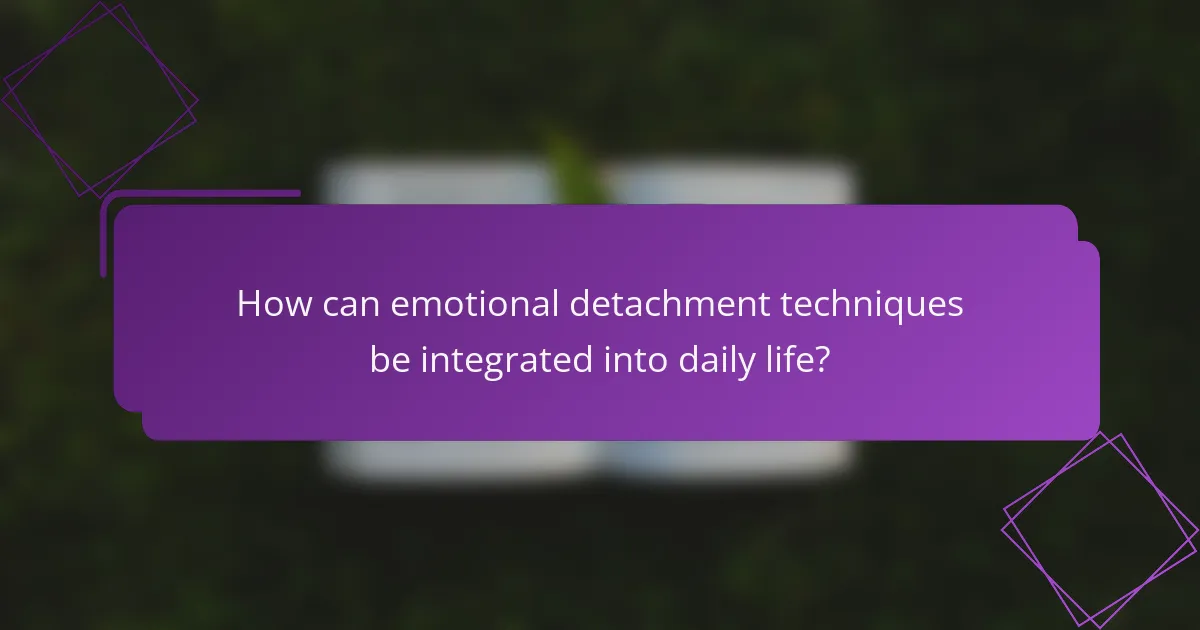
How can emotional detachment techniques be integrated into daily life?
Emotional detachment techniques can be seamlessly incorporated into daily routines by practicing mindfulness, setting boundaries, and engaging in self-reflection. These methods help individuals manage their emotional responses and maintain a healthy distance from overwhelming feelings.
Mindfulness Practices
Mindfulness practices involve being present in the moment and observing thoughts and feelings without judgment. Techniques such as meditation, deep breathing, or mindful walking can help cultivate emotional detachment. For instance, dedicating just 10 minutes a day to meditation can significantly enhance your ability to detach from strong emotions.
To implement mindfulness, consider using apps that guide you through meditation or joining local classes. Regular practice can improve your emotional resilience and reduce stress levels over time.
Setting Boundaries
Setting boundaries is crucial for maintaining emotional detachment. This involves clearly defining what behaviors you will accept from others and communicating these limits effectively. For example, if certain conversations trigger strong emotions, it’s important to express your need to avoid those topics.
Establishing boundaries can prevent emotional overload and promote healthier relationships. Remember to review and adjust your boundaries as necessary, ensuring they align with your emotional well-being.
Self-Reflection Techniques
Self-reflection techniques encourage individuals to analyze their thoughts and feelings critically. Journaling is a practical method for self-reflection, allowing you to articulate emotions and identify patterns in your responses. Aim to write for a few minutes each day to track your emotional triggers and responses.
Additionally, consider discussing your reflections with a trusted friend or therapist. This can provide new perspectives and enhance your understanding of your emotional landscape, aiding in the detachment process.


